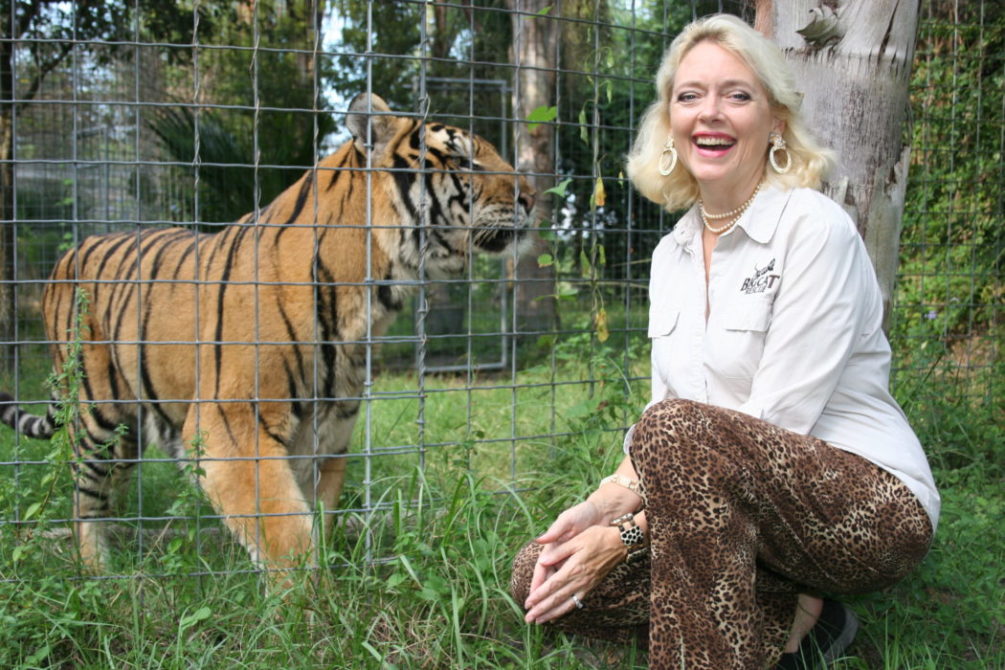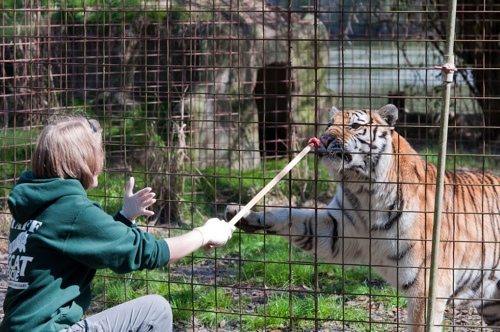CEO Magazine profiles Carole Baskin
She’s a Tiger
By Pegi Dahl Download Original
Carole Baskin, CEO of Big Cat Rescue
Haley had worked diligently for the yearbook staff since 7th grade and now that she was entering her 12th school year she would be helping to prepare the most important one, her senior yearbook. And more importantly, she wanted her own photo as exciting as those she’d handled for other seniors in their yearbooks, and she especially liked the photos where seniors posed with exotic animals. After all, it would be her last high school picture.
Unfortunately, it was. For on the warm, sunny morning of August 28, 2005, bright and bubbly 17-year-old Haley Hilderbrand, a pretty girl who teachers said was a “joy to teach” and who “always smiled” was mauled to death while posing with a Siberian tiger. “It was near the end of the photo session. Haley was sort of standing in a straddled position over the lying tiger when he licked her foot” said a friend who witnessed the event. Startled, Haley yanked her foot away and squealed, causing the massive 550 pound animal to stand, knocking the teenager to the ground then instinctively locking his massive jaws around the back of her neck, snapping her spine.
It was fast. And eerily similar to what happened to Roy of Siegfried and Roy’s famed Las Vegas show. Roy Horn swears the white tiger he raised from a cub would not have intentionally harmed him, although he remains in a wheelchair, partially paralyzed with brain injuries after this “pet” attacked him, and dragged the entertainer off stage with massive jaws clenched onto Roy’s neck. A 2-year investigation by the USDA concluded in a 233-page report that despite Horn’s claim the tiger did, indeed, attack him and concluded that the attack was without provocation.
“The tiger did what tigers do,” testified Haley Hilderbrand’s mother before a Congressional committee. She, like so many loving parents, was shocked to learn that her daughter’s big cat tragedy was only one of over 50 documented cases in the last five years in the US alone. Over 800 big cat incidents and more than 68 reported fatalities have occurred since 1990.
“There are countless reasons why big cats should not be bred for life in cages and no reason other than human ego for allowing the practice,” says Carole Baskin, founder and CEO of Big Cat Rescue, as she details the exploitation of these majestic animals by backyard breeders, roadside tourist traps, flea market attractions and people who charge a fee to drag a leashed lion or tiger into a classroom or party and call themselves educators. “Many claim to have sanctuaries or training facilities (like the one where Haley was mauled to death) but they do not. They make their money charging the public to feed, pet or pose with the cute cubs. But a cub will grow quickly into a dangerous and expensive big cat, so a new litter must be cultivated every few months. Without a legitimate market, these older cats are most often disposed of or driven to emotional distress spending years in cramped cages, left to face a cruel and languishing death.”
So, with what began simply as a local movement to protect other children, the family, friends and townspeople whose lives were touched by Haley Hilderbrand’s unnecessary death have continued their pursuit. They seek an amendment to the Animal Welfare Act that will ban the public from direct contact with big cats and big cat babies. And they are doing so with the help of big cat experts like Carole Baskin.
When you meet Carole your first question is immediately obvious. How does a woman so pretty and so gentile-looking as this lady, a 5’6″ slender blond with butter-cream skin, alluring azure eyes, a soft-spoken demeanor and demure smile, ever become a leading authority on the behavior of a mighty 550 lb. Siberian tiger? Hardly easy. To become an authority in the same manner as Carole, you’d first have to turn 45 acres of raw land into the largest accredited wildcat rescue facility in the world, develop a website which attracts over 30,000 page views a day and then write a paper outstanding enough to become published text at Cambridge University. And you’d have to do it the hard way.
Once a successful real estate investor, Carole could have retired to a life of leisure. But that wasn’t her calling. Something snapped on a crisp, cold day in 1993 when Carole and her late husband visited a Minnesota breeder to purchase a bobcat as a pet. This breeder turned out to be a fur farm. “The cats were in cages several inches deep with layers of fur and feces.” Carole recalls. “The flies were so thick in the metal shed that we had to put hankies over our faces just to breathe without inhaling them. On the floor was a stack of partially skinned bobcats, Canada lynx and Siberian lynx. Their bellies had been cut off, as this soft, spotted fur is the only portion used in making fur coats. In horror and disbelief.I couldn’t speak.and now the pile of dead cats in the corner hit me with the reality of a freight train.”
Even worse, Carole recalls “was the sight of 56 lynx awaiting slaughter (often by thrusting an electrocution rod into their anus) that made me throw caution to the wind and bring them all home. My life changed forever that day. We bought every carrier, basket, toolbox or bucket that you could put a cat in and bales of hay for nesting for the ride from Minnesota to Florida. As my husband drove, the rest of us tended to babies that had to be fed every two hours for the next two months. It was many months later before any of us slept through the night because we didn’t know what we were doing and there was no one to turn to for advice. We dealt with every imaginable sickness plus the increasing demands on our time from these carnivores that rely so heavily on their mothers for the first one to three years of life.”
Of that catalytic event, Carole reflects, you discover “something has happened inside you. It’s more of an internal event than an external one. It’s not entirely about what you see happen in the world, but about strength you see inside yourself. It’s not learning something new about a problem but rather learning something new about your unique ability to contribute to it’s solution.”
“Initially we brought the cats to our home” she remembers. “Then we started building cages on the current site of the sanctuary.that began long hours, hard work, learning, sometimes by trial and error.and much heartbreak over what we found other animals enduring.” Ironically, the narrow road to Carole’s home, and now her life’s work, was named “Easy Street”.
Easy Street is a compacted nature trail of a lane that brings visitors to the main gate at Big Cat Rescue. It spills from a small hole in the woods unto the bustling 6-lane thoroughfare across from Tampa’s busy Citrus Park Mall.
“Don’t be scared by the dirt road”, quipped a visitor from Buford, GA. “Perseverance will be rewarded. I had never been so close to wild big cats.fascinating. A knowledgeable guide takes a small group of visitors around the grounds showing the beautiful cats housed in secure enclosures. Sometimes the cats are hiding and that’s okay. This place exists for the animals, not the public, which suited me perfectly. Each cat is presented with its unique personality and characteristics along with its origin. Some of the stories are heartbreaking. The people who run the place obviously care a great deal about their rescued cats and do their best to provide the best life possible. It’s not circus-like.it’s for rescue, conservation and education. I cannot encourage you strongly enough to visit this place.”
The visitor is right. It requires over 100 caring, giving volunteers to tend the nearly 150 wildcats at the sanctuary. You’ll see lions, tigers, leopards, jaguars, bobcats, lynx.16 species and sub-species in all, the largest variety assembled anywhere on earth. “We purchase, prepare and distribute over 500 pounds of meat a day,” says Scott Lope, Big Cat Rescue’s Director of Operations and one of only eight paid employees. Then there is the cleaning of the Cat-a-tat compounds, maintaining the grounds, ponds, shelters and fencing, providing an onsite medical facility, guiding tours, operating the gift shop and much, much more. The volunteers are totally dedicated.
Carole herself feels very strongly about the intention of her people. “.a small group of committed people and a powerful idea can lead to big change. All successful human endeavors begin with the assumption that change is possible. We all want to live a life of value; to repair the world and to right the wrongs of the less enlightened. This is the work of a heroic people. This is the work of people like you (volunteers and staff) who dared to see what you could do to get involved.I live in gratitude.” What a powerful attitude for any CEO.
When asked what it is like to run a sanctuary, Carole is fast on the answer. “Emotionally, it is like standing under a waterfall of suffering creatures and having to make the agonizing choice of who you will rescue and who you will turn away.” Folks have no idea how many captive big cats are living as pets, perhaps as many as 15,000 in the US with Florida having the highest concentration of breeders. The Palm Beach Post reported 1455 tigers live as pets in Florida. When a cub bought for $200 turns into an adult requiring $7,500 a year to feed and care for, the pet owner turns to people like Carole to take the “problem” off his hands.
“Each year we were in business the requests to take cats doubled,” she claims. “By 2003 we had to refuse 312 unwanted cats. We just cannot become a dumping ground for irresponsible breeders and pet owners as that only enables the practice to continue. So we turned our focus to education and legislation to stop the abuse at its source.”
“Haley’s Act is the most important piece of legislation we can pass,” states Carole emphatically as she hands over a binder she and her team have generously stuffed with documents and information supplicating the necessity of passing bill HR1947. “It will stop 90% of the problem.” Haley’s Act is now before the House Agriculture Committee so she and her husband, Howard Baskin, have been in Washington DC all week trekking down Senate corridors, going office to office impacting opinion. Howard, a graduate of Union College, University of Miami School of Law and Harvard Business School was semi-retired from management consulting and strategic planning when the couple married four years ago. Now he helps with the lobbying efforts in Tallahassee and Washington DC, handles finances and fundraising for the sanctuary and distributes cow ribs on bone night. “I’m just looking forward to the day when the sanctuary is financially self-sustaining and I can take a half day off for golf,” he teases. Now that’s dedication.
Help Carole and the dedicated folks at Big Cat Rescue continue to take a bite out of animal abuse through legislation and educational programs. Visit their many videos and resources online at bigcatrescue.org or experience the intrigue of the big cats live by taking a guided walking tour.
https://www.tampabayceo.com/1010cat.html






Excellent article on a very dedicated woman. The Big Cat Rescue is one of the finest we have ever visited. In addition to providing a sanctuary for so many needy Big Cats Ms Baskin continues to fight for legislation to halt private ownership and abuse of wild animals. Many many animals will be saved from abuse and mishandling due to her efforts.